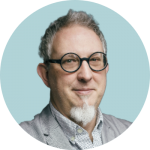Are you curious about design workshops? Either as a participant who wants to get more out of your collaboration or as a facilitator leading projects, design workshops can bring new direction to your process. The more we know about how they work, and work best, the more we can all benefit from their opportunities.
At Factor, we regularly conduct design workshops with our clients and partners as part of our iterative process. We find that these guided collaborative work sessions are great opportunities for active idea generation. As part of our commitment to building local community in UX, we also lead design workshops at schools and meetups. Each new teaching opportunity is a learning opportunity, and helps us make our workshops more productive for participants.
This past weekend I led a design workshop for ASIS&T’s University of Washington Chapter. Participants came from the UW’s Information School, with a range of different academic focuses and backgrounds. Some had design experience, others were completely new to it. This kind of diversity usually makes for a lively workshop, and this was no exception.
We started with an interactive presentation an digital collaboration to introduce key topics and guide the activity. Directly afterwards, we began the workshop by dividing the room into 5 teams of 5 (roughly) and described our challenge: Design an app for a “locavore” produce subscription service. Although an app was the focus, the challenge was crafted to force participant teams to think about the service behind the app.
We use the Charrette format to frame our workshops (if you’re not familiar with Charrettes, the Nielsen Norman group offers a working definition.) Factor workshops use three strictly timeboxed sessions.
-
Individual sketching, where participants are encouraged to sketch as many ideas as they can in five minutes. People work alone to bring as many personal ideas as possible forward to the next section.
-
Consolidation, teams have ten minutes to come together to try to combine and extend their ideas. They can de-duplicate and combine their ideas towards a cohesive whole.
-
Pitch development, where teams spend ten minutes building a pitch for their concept.
At the end of the design sessions, each team has three minutes to pitch their concept to the rest of the room, and face questions from the group at large. EVERY participant from each team must take part in that team’s presentation. The amount of time needed can depend on the size of your main group and teams (as well as your schedule for the day.)
The ASIS&T UW workshop generated ideas and questions too rich and varied to enumerate here. But as in the past, when we’ve given these workshops with similar challenges, the participants came up with ideas that had never occurred to me. As I mentioned in my last post about teaching, there’s always room for innovation! Design workshops are a great way to demonstrate it in your projects.
I’ll be eager to see if any of the students in this workshop were inspired to pursue this idea as an opportunity for entrepreneurship. I’d like to thank Anne Nguyen, Erika Deal, Rachel Price and all the other ASIS&T volunteers for hosting this workshop series. Most of all I’d like to thank all the participants for bringing all that creative energy and enthusiasm at 10:00 AM on a Saturday morning!
Have you participated in or led design workshops? I’d like to hear about your experiences. What workshop formats have worked for you and how have they led to actionable design solutions? Let us know in the comments or share your thoughts with us at @factorfirm.com.



